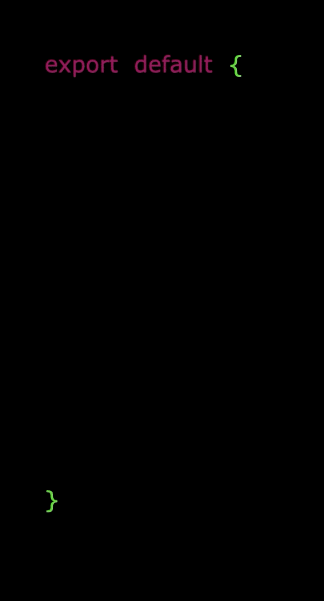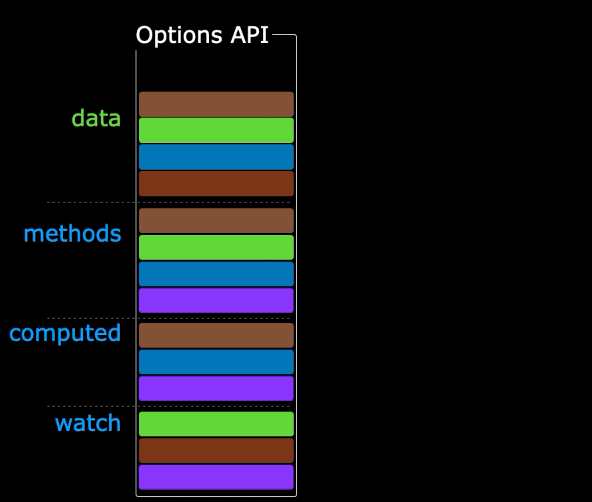Vue3核心语法
OptionsAPI 与 CompositionAPI
Vue2的API设计是Options(配置)风格的。Vue3的API设计是Composition(组合)风格的。
Options API 的弊端
Options类型的 API,数据、方法、计算属性等,是分散在:data、methods、computed中的,若想新增或者修改一个需求,就需要分别修改:data、methods、computed,不便于维护和复用。

Composition API 的优势
可以用函数的方式,更加优雅的组织代码,让相关功能的代码更加有序的组织在一起。

setup函数常用的方式
在 setup() 函数中返回的对象会暴露给模板和组件实例
其他的选项也可以通过组件实例来获取 setup() 暴露的属性:
<script>
import { ref } from 'vue'
export default {
setup() {
const count = ref(0)
// 返回值会暴露给模板和其他的选项式 API 钩子
return {
count
}
},
mounted() {
console.log(this.count) // 0
}
}
</script>
<template>
<button @click="count++">{{ count }}</button>
</template>
- setup函数中无法访问this
- 如果该组件是 Suspense 组件的后裔,可以是异步async setup()
- 也可以直接返回一个函数或者是代替模版显示的内容
setup(){
return ()=> '这里直接替换模版显示的内容'
} setup函数会在beforeCreate之前调用,它是“领先”所有钩子执行的
访问props
export default {
props: {
title: String
},
setup(props) {
console.log(props.title)
}
}
Setup 上下文
export default {
setup(props, context) {
// 透传 Attributes(非响应式的对象,等价于 $attrs)
console.log(context.attrs)
// 插槽(非响应式的对象,等价于 $slots)
console.log(context.slots)
// 触发事件(函数,等价于 $emit)
console.log(context.emit)
// 暴露公共属性(函数)
console.log(context.expose)
}
}
暴露公共属性
export default {
setup(props, { expose }) {
// 让组件实例处于 “关闭状态”
// 即不向父组件暴露任何东西
expose()
const publicCount = ref(0)
const privateCount = ref(0)
// 有选择地暴露局部状态
expose({ count: publicCount })
}
}
setup 与 Options API 的关系
Vue2的配置(data、methos......)中可以访问到setup中的属性、方法。- 但在
setup中不能访问到Vue2的配置(data、methos......)。 - 如果与
Vue2冲突,则setup优先。
setup 语�法糖
setup函数有一个语法糖,这个语法糖,可以让我们把setup独立出去,代码如下:
<template>
<div class="person">
<h2>姓名:{{name}}</h2>
<h2>年龄:{{age}}</h2>
<button @click="changName">修改名字</button>
<button @click="changAge">年龄+1</button>
<button @click="showTel">点我查看联系方式</button>
</div>
</template>
<script lang="ts">
export default {
name:'Person',
}
</script>
<!-- 下面的写法是setup语法糖 -->
<script setup lang="ts">
console.log(this) //undefined
// 数据(注意:此时的name、age、tel都不是响应式数据)
let name = '张三'
let age = 18
let tel = '13888888888'
// 方法
function changName(){
name = '李四'//注意:此时这么修改name页面是不变化的
}
function changAge(){
console.log(age)
age += 1 //注意:此时这么修改age页面是不变化的
}
function showTel(){
alert(tel)
}
</script>
扩展:上述代码,还需要编写一个不写setup的script标签,去指定组件名字,比较麻烦,我们可以借助vite中的插件简化
- 第一步:
npm i vite-plugin-vue-setup-extend -D - 第二步:
vite.config.ts
import { defineConfig } from 'vite'
import VueSetupExtend from 'vite-plugin-vue-setup-extend'
export default defineConfig({
plugins: [ VueSetupExtend() ]
})
- 第三步:
<script setup lang="ts" name="Person">
响应式数据
ref 对比 reactive
宏观角度看:
ref用来定义:基本类型数据、对象类型数据;
reactive用来定义:对象类型数据。
- 区别:
ref创建的变量必须使用.value(可以使用volar插件自动添加.value)。
reactive重新分配一个新对象,会失去响应式(可以使用Object.assign去整体替换)。
- 使用原则:
- 若需要一个基本类型的响应式数据,必须使用
ref。- 若需要一个响应式对象,层级不深,
ref、reactive都可以。- 若需要一个响应式对象,且层级较深,推荐使用
reactive。
toRefs 与 toRef
- 作用:将一个响应式对象中的每一个属性,转换为
ref对象。 - 备注:
toRefs与toRef功能一致,但toRefs可以批量转换。
计算属性
作用:根据已有数据计算出新数据(和Vue2中的computed作用一致)。
<template>
<div class="person">
姓:<input type="text" v-model="firstName"> <br>
名:<input type="text" v-model="lastName"> <br>
全名:<span>{{fullName}}</span> <br>
<button @click="changeFullName">全名改为:li-si</button>
</div>
</template>
<script setup lang="ts" name="App">
import {ref,computed} from 'vue'
let firstName = ref('zhang')
let lastName = ref('san')
// 计算属性——只读取,不修改
/* let fullName = computed(()=>{
return firstName.value + '-' + lastName.value
}) */
// 计算属性——既读取又修改
let fullName = computed({
// 读取
get(){
return firstName.value + '-' + lastName.value
},
// 修改
set(val){
console.log('有人修改了fullName',val)
firstName.value = val.split('-')[0]
lastName.value = val.split('-')[1]
}
})
function changeFullName(){
fullName.value = 'li-si'
}
</script>
watch监听
- 作用:监视数据的变化(和
Vue2中的watch作用一致) - 特点:
Vue3中的watch只能监视以下四种数据:
ref定义的数据。reactive定义的数据。- 函数返回一个值(
getter函数)。- 一个包含上述内容的数组。
我们在Vue3中使用watch的时候,通常会遇到以下几种情况:
* 情况一
监视ref定义的【基本类型】数据:直接写数据名即可,监视的是其value值的改变。
<template>
<div class="person">
<h1>情况一:监视【ref】定义的【基本类型】数据</h1>
<h2>当前求和为:{{sum}}</h2>
<button @click="changeSum">点我sum+1</button>
</div>
</template>
<script lang="ts" setup name="Person">
import {ref,watch} from 'vue'
// 数据
let sum = ref(0)
// 方法
function changeSum(){
sum.value += 1
}
// 监视,情况一:监视【ref】定义的【基本类型】数据
const stopWatch = watch(sum,(newValue,oldValue)=>{
console.log('sum变化了',newValue,oldValue)
if(newValue >= 10){
stopWatch()
}
})
</script>
* 情况二
监视ref定义的【对象类型】数据:直接写数据名,监视的是对象的【地址值】,若想监视对象内部的数据,要手动开启深度监视。
注意:
若修改的是
ref定义的对象中的属性,newValue和oldValue都是新值,因为它们是同一个对象。若修改整个
ref定义的对象,newValue是新值,oldValue是旧值,因为不是同一个对象了。
<template>
<div class="person">
<h1>情况二:监视【ref】定义的【对象类型】数据</h1>
<h2>姓名:{{ person.name }}</h2>
<h2>年龄:{{ person.age }}</h2>
<button @click="changeName">修改名字</button>
<button @click="changeAge">修改年龄</button>
<button @click="changePerson">修改整个人</button>
</div>
</template>
<script lang="ts" setup name="Person">
import {ref,watch} from 'vue'
// 数据
let person = ref({
name:'张三',
age:18
})
// 方法
function changeName(){
person.value.name += '~'
}
function changeAge(){
person.value.age += 1
}
function changePerson(){
person.value = {name:'李四',age:90}
}
/*
监视,情况一:监视【ref】定义的【对象类型】数据,监视的是对象的地址值,若想监视对象内部属性的变化,需要手动开启深度监视
watch的第一个参数是:被监视的数据
watch的第二个参数是:监视的回调
watch的第三个参数是:配置对象(deep、immediate等等.....)
*/
watch(person,(newValue,oldValue)=>{
console.log('person变化了',newValue,oldValue)
},{deep:true})
</script>
* 情况三
监视reactive定义的【对象类型】数据,且默认开启了深度监视。
<template>
<div class="person">
<h1>情况三:监视【reactive】定义的【对象类型】数据</h1>
<h2>姓名:{{ person.name }}</h2>
<h2>年龄:{{ person.age }}</h2>
<button @click="changeName">��修改名字</button>
<button @click="changeAge">修改年龄</button>
<button @click="changePerson">修改整个人</button>
<hr>
<h2>测试:{{obj.a.b.c}}</h2>
<button @click="test">修改obj.a.b.c</button>
</div>
</template>
<script lang="ts" setup name="Person">
import {reactive,watch} from 'vue'
// 数据
let person = reactive({
name:'张三',
age:18
})
let obj = reactive({
a:{
b:{
c:666
}
}
})
// 方法
function changeName(){
person.name += '~'
}
function changeAge(){
person.age += 1
}
function changePerson(){
Object.assign(person,{name:'李四',age:80})
}
function test(){
obj.a.b.c = 888
}
// 监视,情况三:监视【reactive】定义的【对象类型】数据,且默认是开启深度监视的
watch(person,(newValue,oldValue)=>{
console.log('person变化了',newValue,oldValue)
})
watch(obj,(newValue,oldValue)=>{
console.log('Obj变化了',newValue,oldValue)
})
</script>
* 情况四
监视ref或reactive定义的【对象类型】数据中的某个属性,注意点如下:
- 若该属性值不是【对象类型】,需要写成函数形式。
- 若该属性值是依然是【对象类型】,可直接编,也可写成函数,建议写成函数。
结论:监视的要是对象里的属性,那么最好写函数式,注意点:若是对象监视的是地址值,需要关注对象内部,需要手动开启深度监视。
<template>
<div class="person">
<h1>情况四:监视【ref】或【reactive】定义的【对象类型】数据中的某个属性</h1>
<h2>姓名:{{ person.name }}</h2>
<h2>年龄:{{ person.age }}</h2>
<h2>汽车:{{ person.car.c1 }}、{{ person.car.c2 }}</h2>
<button @click="changeName">修改名字</button>
<button @click="changeAge">修改年龄</button>
<button @click="changeC1">修改第一台车</button>
<button @click="changeC2">修改第二台车</button>
<button @click="changeCar">修改整个车</button>
</div>
</template>
<script lang="ts" setup name="Person">
import {reactive,watch} from 'vue'
// 数据
let person = reactive({
name:'张三',
age:18,
car:{
c1:'奔驰',
c2:'宝马'
}
})
// 方法
function changeName(){
person.name += '~'
}
function changeAge(){
person.age += 1
}
function changeC1(){
person.car.c1 = '奥迪'
}
function changeC2(){
person.car.c2 = '大众'
}
function changeCar(){
person.car = {c1:'雅迪',c2:'爱玛'}
}
// 监视,情况四:监视响应式对象中的某个属性,且该属性是基本类型的,要写成函数式
/* watch(()=> person.name,(newValue,oldValue)=>{
console.log('person.name变化了',newValue,oldValue)
}) */
// 监视,情况四:监视响应式对象中的某个属性,且该属性是对象类型的,可以直接写,也能写函数,更推荐写函数
watch(()=>person.car,(newValue,oldValue)=>{
console.log('person.car变化了',newValue,oldValue)
},{deep:true})
</script>
* 情况五
监视上述的多个数据
<template>
<div class="person">
<h1>情况五:监视上述的多个数据</h1>
<h2>姓名:{{ person.name }}</h2>
<h2>年龄:{{ person.age }}</h2>
<h2>汽车:{{ person.car.c1 }}、{{ person.car.c2 }}</h2>
<button @click="changeName">修改名字</button>
<button @click="changeAge">修改年龄</button>
<button @click="changeC1">修改第一台车</button>
<button @click="changeC2">修改第二台车</button>
<button @click="changeCar">修改整个车</button>
</div>
</template>
<script lang="ts" setup name="Person">
import {reactive,watch} from 'vue'
// 数据
let person = reactive({
name:'张三',
age:18,
car:{
c1:'奔驰',
c2:'宝马'
}
})
// 方法
function changeName(){
person.name += '~'
}
function changeAge(){
person.age += 1
}
function changeC1(){
person.car.c1 = '奥迪'
}
function changeC2(){
person.car.c2 = '大众'
}
function changeCar(){
person.car = {c1:'雅迪',c2:'爱玛'}
}
// 监视,情况五:监视上述的多个数据
watch([()=>person.name,person.car],(newValue,oldValue)=>{
console.log('person.car变化了',newValue,oldValue)
},{deep:true})
</script>
watchEffect
官网:立即运行一个函数,同时响应式地追踪其依赖,并在依赖更改时重新执行该函数。
watch对比watchEffect
都能监听响应式数据的变化,不同的是监听数据变化的方式不同
watch:要明确指出监视的数据
watchEffect:不用明确指出监视的数据(函数中用到哪些属性,那就监视哪些属性)。
示例代码:
<template>
<div class="person">
<h1>需求:水温达到50℃,或水位达到20cm,则联系服务器</h1>
<h2 id="demo">水温:{{temp}}</h2>
<h2>水位:{{height}}</h2>
<button @click="changePrice">水温+1</button>
<button @click="changeSum">水位+10</button>
</div>
</template>
<script lang="ts" setup name="Person">
import {ref,watch,watchEffect} from 'vue'
// 数据
let temp = ref(0)
let height = ref(0)
// 方法
function changePrice(){
temp.value += 10
}
function changeSum(){
height.value += 1
}
// 用watch实现,需要明确的指出要监视:temp、height
watch([temp,height],(value)=>{
// 从value中获取最新的temp值、height值
const [newTemp,newHeight] = value
// 室温达到50℃,或水位达到20cm,立刻联系服务器
if(newTemp >= 50 || newHeight >= 20){
console.log('联系服务器')
}
})
// 用watchEffect实现,不用
const stopWtach = watchEffect(()=>{
// 室温达到50℃,或水位达到20cm,立刻联系服务器
if(temp.value >= 50 || height.value >= 20){
console.log(document.getElementById('demo')?.innerText)
console.log('联系服务器')
}
// 水温达到100,或水位达到50,取消监视
if(temp.value === 100 || height.value === 50){
console.log('清理了')
stopWtach()
}
})
</script>
标签的 ref 属性
作用:用于注册模板引用。
用在普通
DOM标签上,获取的是DOM节点。用在组件标签上,获取的是组件实例对象。
用在普通DOM标签上:
<template>
<div class="person">
<h1 ref="title1">尚硅谷</h1>
<h2 ref="title2">前端</h2>
<h3 ref="title3">Vue</h3>
<input type="text" ref="inpt"> <br><br>
<button @click="showLog">点我打印内容</button>
</div>
</template>
<script lang="ts" setup name="Person">
import {ref} from 'vue'
let title1 = ref()
let title2 = ref()
let title3 = ref()
function showLog(){
// 通过id获取元素
const t1 = document.getElementById('title1')
// 打印内容
console.log((t1 as HTMLElement).innerText)
console.log((<HTMLElement>t1).innerText)
console.log(t1?.innerText)
/************************************/
// 通过ref获取元素
console.log(title1.value)
console.log(title2.value)
console.log(title3.value)
}
</script>
用在组件标签上:
<!-- 父组件App.vue -->
<template>
<Person ref="ren"/>
<button @click="test">测试</button>
</template>
<script lang="ts" setup name="App">
import Person from './components/Person.vue'
import {ref} from 'vue'
let ren = ref()
function test(){
console.log(ren.value.name)
console.log(ren.value.age)
}
</script>
<!-- 子组件Person.vue中要使用defineExpose暴露内容 -->
<script lang="ts" setup name="Person">
import {ref,defineExpose} from 'vue'
// 数据
let name = ref('张三')
let age = ref(18)
/****************************/
/****************************/
// 使用defineExpose将组件中的数据交给外部
defineExpose({name,age})
</script>
props
// 定义一个接口,限制每个Person对象的格式
export interface PersonInter {
id:string,
name:string,
age:number
}
// 定义一个自定义类型Persons
export type Persons = Array<PersonInter>
App.vue中代码:<template>
<Person :list="persons"/>
</template>
<script lang="ts" setup name="App">
import Person from './components/Person.vue'
import {reactive} from 'vue'
import {type Persons} from './types'
let persons = reactive<Persons>([
{id:'e98219e12',name:'张三',age:18},
{id:'e98219e13',name:'李四',age:19},
{id:'e98219e14',name:'王五',age:20}
])
</script>
Person.vue中代码:<template>
<div class="person">
<ul>
<li v-for="item in list" :key="item.id">
{{item.name}}--{{item.age}}
</li>
</ul>
</div>
</template>
<script lang="ts" setup name="Person">
import {defineProps} from 'vue'
import {type PersonInter} from '@/types'
// 第一种写法:仅接收
// const props = defineProps(['list'])
// 第二种写法:接收+限制类型
// defineProps<{list:Persons}>()
// 第三种写法:接收+限制类型+指定默认值+限制必要性
let props = withDefaults(defineProps<{list?:Persons}>(),{
list:()=>[{id:'asdasg01',name:'小猪佩奇',age:18}]
})
console.log(props)
</script>
生命周期
-
概念:
Vue组件实例在创建时要经历一系列的初始化步骤,在此过程中Vue会在合适的时机,调用特定的函数,从而让开发者有机会在特定阶段运行自己的代码,这些特定的函数统称为:生命周期钩子 -
规律:
生命周期整体分为四个阶段,分别是:创建、挂载、更新、销毁,每个阶段都有两个钩子,一前一后。
-
Vue2的生命周期创建阶段:
beforeCreate、created挂载阶段:
beforeMount、mounted更新阶段:
beforeUpdate、updated销毁阶段:
beforeDestroy、destroyed -
Vue3的生命周期创建阶段:
setup挂载阶段:
onBeforeMount、onMounted更新阶段:
onBeforeUpdate、onUpdated卸载阶段:
onBeforeUnmount、onUnmounted -
常用的钩子:
onMounted(挂载完毕)、onUpdated(更新完毕)、onBeforeUnmount(卸载之前) -
示例代码:
<template>
<div class="person">
<h2>当前求和为:{{ sum }}</h2>
<button @click="changeSum">点我sum+1</button>
</div>
</template>
<!-- vue3写法 -->
<script lang="ts" setup name="Person">
import {
ref,
onBeforeMount,
onMounted,
onBeforeUpdate,
onUpdated,
onBeforeUnmount,
onUnmounted
} from 'vue'
// 数据
let sum = ref(0)
// 方法
function changeSum() {
sum.value += 1
}
console.log('setup')
// 生命周期钩子
onBeforeMount(()=>{
console.log('挂载之前')
})
onMounted(()=>{
console.log('挂载完毕')
})
onBeforeUpdate(()=>{
console.log('更新之前')
})
onUpdated(()=>{
console.log('更新完毕')
})
onBeforeUnmount(()=>{
console.log('卸载之前')
})
onUnmounted(()=>{
console.log('卸载完毕')
})
</script>
嵌套父子组件
vue2
当父组件和子组件一起加载时,控制台输出如下:
- Parent beforeCreate
- Parent created
- Parent beforeMount 在这里去递归子组件
- Child beforeCreate
- Child created
- Child beforeMount
- Child mounted
- Parent mounted
组件更新时的顺序
- Parent beforeUpdate
- Child beforeUpdate
- Child updated
- Parent updated
组件销毁时的顺序
- Parent beforeDestroy
- Child beforeDestroy
- Child destroyed
- Parent destroyed
总结 Vue 2 的生命周期钩子函数在父子组件之间的执行顺序如下:
在创建和挂载时,父组件的钩子先执行,接着是子组件的钩子。
在更新时,父组件的 beforeUpdate 钩子先执行,接着是子组件的 beforeUpdate,然后是子组件的 updated,最后是父组件的 updated。
在销毁时,父组件的 beforeDestroy 钩子先执行,接着是子组件的 beforeDestroy,然后是子组件的 destroyed,最后是父组件的 destroyed。
vue3
当父组件和子组件一起加载时,控制台输出如下:
- Parent setup
- Parent beforeMount
- Child setup
- Child beforeMount
- Child mounted
- Parent mounted
组件更新时的顺序
- Parent beforeUpdate
- Child beforeUpdate
- Child updated
- Parent updated
组件销毁时的顺序
- Parent beforeUnmount
- Child beforeUnmount
- Child unmounted
- Parent unmounted 总结
生命周期钩子函数的执行顺序如下:
在创建和挂载时,父组件的 setup 和生命周期钩子先执行,接着是子组件的 setup 和生命周期钩子。
在更新时,父组件的 beforeUpdate 钩子先执行,接着是子组件的 beforeUpdate,然后是子组件的 updated,最后是父组件的 updated。
在销毁时,父组件的 beforeUnmount 钩子先执行,接着是子组件的 beforeUnmount,然后是子组件的 unmounted,最后是父组件的 unmounted。
自定义hook
-
什么是
hook?—— 本质是一个函数,把setup函数中使用的Composition API进行了封装,类似于vue2.x中的mixin。 -
自定义
hook的优势:复用代码, 让setup中的逻辑更清楚易懂。
示例代码:
-
useSum.ts中内容如下:import {ref,onMounted} from 'vue'
export default function(){
let sum = ref(0)
const increment = ()=>{
sum.value += 1
}
const decrement = ()=>{
sum.value -= 1
}
onMounted(()=>{
increment()
})
//向外部暴露数据
return {sum,increment,decrement}
} -
useDog.ts中内容如下:import {reactive,onMounted} from 'vue'
import axios,{AxiosError} from 'axios'
export default function(){
let dogList = reactive<string[]>([])
// 方法
async function getDog(){
try {
// 发请求
let {data} = await axios.get('https://dog.ceo/api/breed/pembroke/images/random')
// 维护数据
dogList.push(data.message)
} catch (error) {
// 处理错误
const err = <AxiosError>error
console.log(err.message)
}
}
// 挂载钩子
onMounted(()=>{
getDog()
})
//向外部暴露数据
return {dogList,getDog}
} -
组件中具体使用:
<template>
<h2>当前求和为:{{sum}}</h2>
<button @click="increment">点我+1</button>
<button @click="decrement">点我-1</button>
<hr>
<img v-for="(u,index) in dogList.urlList" :key="index" :src="(u as string)">
<span v-show="dogList.isLoading">加载中......</span><br>
<button @click="getDog">再来一只狗</button>
</template>
<script lang="ts">
import {defineComponent} from 'vue'
export default defineComponent({
name:'App',
})
</script>
<script setup lang="ts">
import useSum from './hooks/useSum'
import useDog from './hooks/useDog'
let {sum,increment,decrement} = useSum()
let {dogList,getDog} = useDog()
</script>